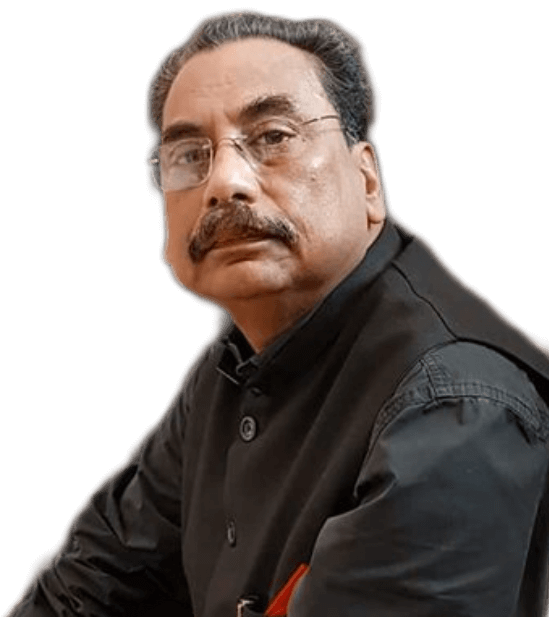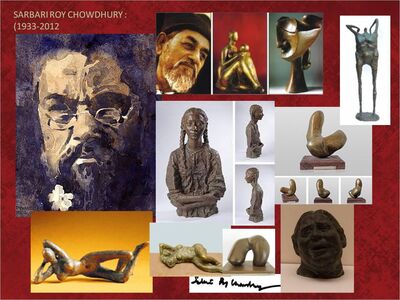Sarbari Roy Chowdhury the eminent sculptor passed away yesterday, the 21st. February 2012. I met Sarbari da only once in 1995. I was then with Gujarat Ambuja Cements working with Harsh Neotia to build 'Swabhumi', the Heritage Park and was also involved with the Rajarhat New Town Project.
You see, the responsibility of the initial plan of Rajarhat was bestowed to Harsh by the then Chief Minister Jyoti Basu and we were planning the stone laying inauguration ceremony. Harsh felt that we should have a sculpture piece for the opening.
I went to meet Sarbarai da in his studio in Santineketan. You could have mistaken him for a professor. I think with his prince-nez. He was working on a piece and if I remember correctly on a torso. There was a music playing in the background, most probably a piano concerto of Schumann. He would work on it for a minute and then took a step back to take a long view. Sort of a world view through his glass.
Having reached the destination, I lost nerve. Seeing him working I felt how ridiculous an idea I was to moot. I felt a little lost and floundered. Mustering courage I shared the idea. He was patient with me but declined. He said that a large sculptor would take years. He has to imbibe the city plan and then proceed. He said that however grand the idea might sound it is a difficult proposal and can only be met by an amateur at such a short period of time. However I must add, that he took a great interest in my work , that related to the building of the Heritage Park.
He took me round his studio offered me a cup of tea and politely showed me the door. That is Sarbari Roy Chowdhury. Not to be taken by commissioned work even at the cost of losing a fortune.
For Sarbari Roy Chowdhury, music was the inspiration for his work. One of India’s leading sculptors, he believed that the abstraction of music can only be expressed through another abstract form. For him, music and painwere the two elements that transformed an intellectual perception into an experience. Through his work of line and volume he aspired to create a visual form of music, seeking forms that contain rhythmical lines similar to Indian classical music. Alberto Giacometti, whom he met have strongly influenced him. In Sarbari’s own words: “I believe that every artist’s source of inspiration is Adirasa. That may be the reason why my creation is inspired by the subtle beauty of the human body.”
Sarbari da adored Alberto Giacometti the Swiss sculptor, painter, draughtsman, and printmaker. His admiration of Giacometti was so great that he not only visited his grave in his second trip of Europe but had contemplated doing a monument devoted to the master in Santineketan.
Sarbari Roychowdhury was born in 1933 in Ulpur, East Bengal, now Bangladesh, into a Zamindari family. He graduated from the Government College of Art and Craft, Kolkata, in 1956, and later studied under the sculptors Prodosh Dasgupta and Sankho Chaudhuri at the M.S. University, Baroda. Between 1960 and 1962, he served as the Head of the Department of Sculpture at the Indian Art College, Kolkata.
Influenced by Indian sculptors like Prodosh Dasgupta as well as Western greats like Rodin, Roy Chowdhury found his inspiration in Hindustani classical music. His works, while pictorial are also largely abstract in their style – perhaps a result of his travels to the Academia de Belle Arti, Florence, in 1962, where he met Giacometti and Henry Moore in person, who along with Sankho Chaudhuri had an undeniable impact on his style. His sculptures feature a unique mix of the academic realism of the East and the more innovative cubism and abstraction of the West.
Roy Chowdhury has won several awards including the Gagan-Abani Puraskar from Visva Bharati University, Santiniketan, in 2004, and the Abanindra Puraskar from the Government of West Bengal in 2005. Over the years he has exhibited his works at several group and solo shows, the latest of which was a retrospective entitled ‘Sensibility Objectified – The Sculptures of Sarbari Roy Chowdhury’ held in May 2009 in New Delhi.

